Reading the comments from our fail blog; we discovered that many people still use Sea Foam with success in cleaning carbony gunk off the innards of their internal combustion engines. We admit that we know about Sea Foam and know it’s been around longer than we’ve been wasting oxygen on this planet. Heck, even our Grandpa used this stuff every spring in the fuel system of his outboard motor on his fishing boat. It would turn the glue in the gas tank back into gas and make the old Evinrude smoke a little less.
But first, we wanted to know a little more about Sea Foam so we perused their literature on the their website. We discovered that it is 100% petroleum based product which surprised us because the stuff smells like a combo of kerosene and moonshine. The short version is that Sea Foam converts carbon back to oil from which carbon buildup came from in your engine. So, Sea Foam will melt carbon back into oil. Great!! Just what we needed. If Sea Foam works as advertised, the mounds of carbon buildup in our 350 will be squeaky clean by sun down.
We ran down to local parts store and paid $10 for a bottle of this stuff. It’s also available in gallon and 55 gallon drum sizes. According to the instructions on the bottle, Sea Foam can be used in the fuel system and in the crankcase. Adding to the fuel will clean out the gummed up fuel lines, carbs and injectors. Adding to the crankcase will clean out the carbon build up inside the engine. We are going to be adding into the engine while it’s running as per the instructions.
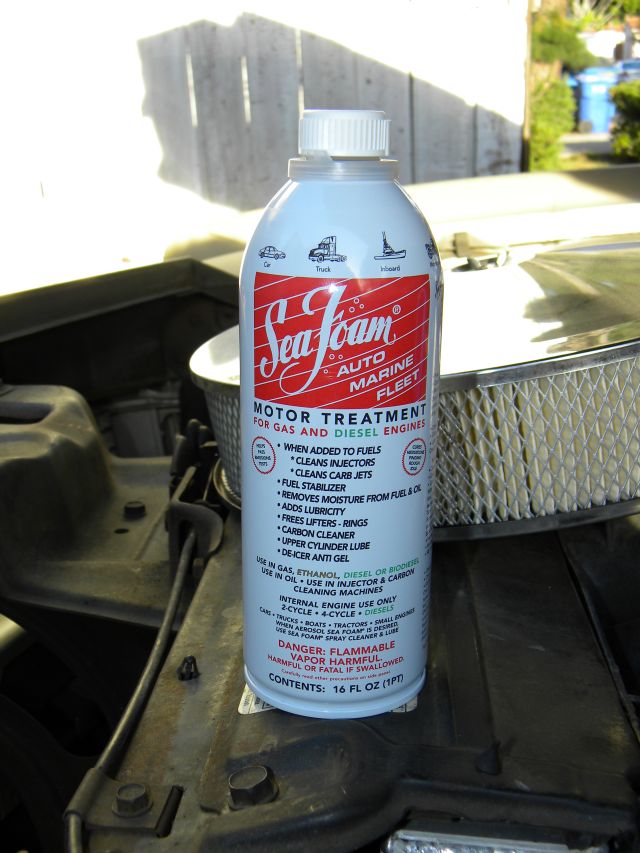
The instructions say to slowly pour Sea Foam into a vacuum line so it will be sucked into the combustion chambers while the engine is running. That vacuum port also has to be located so that when Sea Foam is sucked into the engine it will go evenly into all the cylinders. So first we needed to figure out how to pour it into a vacuum line. In this case, we thought it best to go with a bigger vacuum port, like the 3/8th’s line from the pcv or the brake booster. We chose the pcv port on the front of our Edelbrock carb. We got our cheap funnel with the corrugated tube we used in our last installment and found it fit the port tightly enough to seal it. We also discovered that the funnel whistled loudly with the engine running.
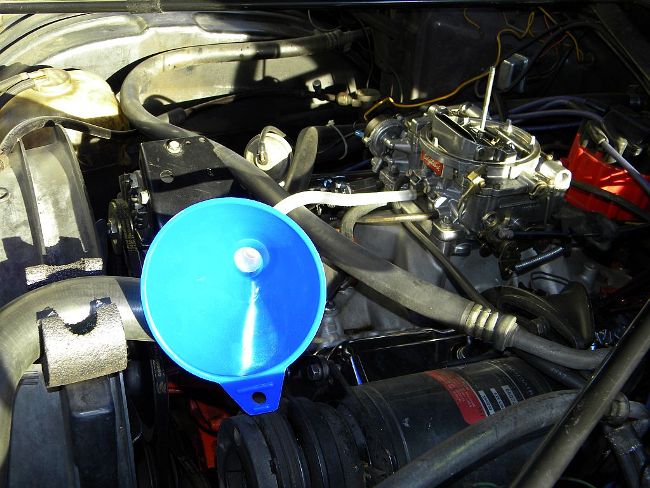
We bumped up the idle speed a tad, but it wasn’t necessary as the idle went up because of the vacuum leak we caused. Holding the funnel straight up worked the best for getting the Sea Foam to suck into the running engine. The directions say to pour SLOWLY about one third of the bottle into the engine with it’s running. That’s what we did.
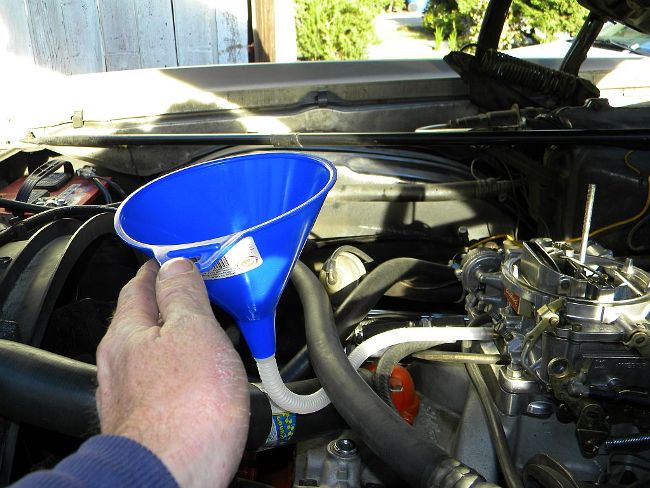
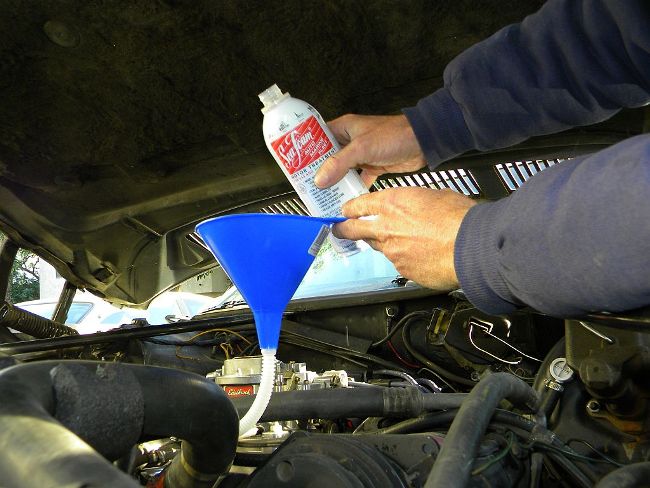
While pouring the Sea Foam into the engine we noticed a few unusual things happening. First, the engine started running hotter than normal. The air being pulled through the radiator got noticeably hotter as we were pouring. Also, smoke started coming out of the air breather on the valve cover. Finally, we had four three foot long trails of carbon on the driveway behind the car. We’re still not sure how we had four trails as we only have two tailpipes. But, carbon being spit out of tailpipes means it’s being cleaned out of somewhere.
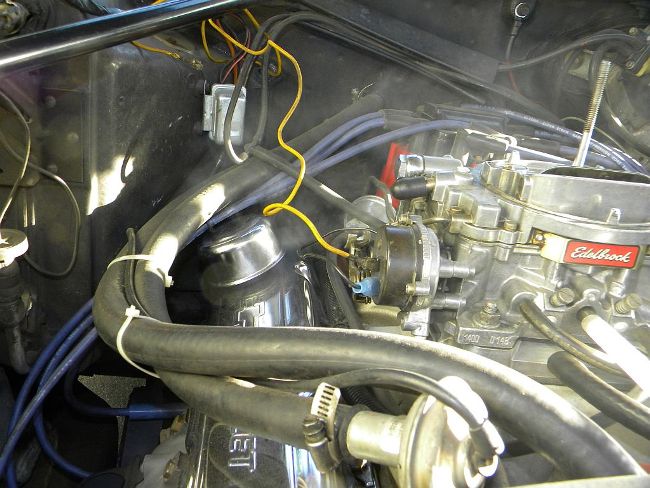
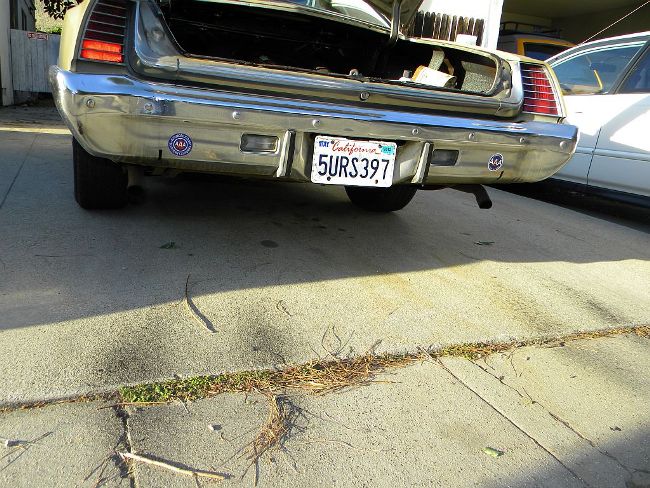
After pouring one third of the bottle into the funnel, the instructions say to shut off the engine for five minutes. Then, we restarted the car and goosed the gas a couple of times to blow out the cylinders of loose carbon. Boy, did the carbon blow out. Our four trails of carbon on the driveway got real black and sutty. The engine sounded like it was breathing better, so we’re sure whatever Sea Foam did, it was an improvement.

One other interesting thing of note was happening during this excercise. Our Monte’s front seal was leaking oil pretty badly. At first, we thought this might have been the cause of the oil going missing from our engine, but realized if the car had been leaking oil this badly all this time, we’d have a pretty good size lake of oil on the driveway under the car by now. In any case, we got out the RTV and slathered it all over the front seal to keep it from leaking any more.



























Good idea using the funnel! I’ve always just poured it down the carb alternating left and right planes.
I’ve always dumped it in the brake booster vacuum line. The trick that I’ve figured out is NOT to shut the motor down, but instead to dump the Seafoam really fast at the end and it will choke the motor out and kill it. Let it sit for a while, then start it back up and you will smoke out the neighborhood with smoke.
Judging by those carbon stripes it did SOMETHING. It’ll be interesting to see exactly what it did. Best of luck!
Dan
Are you guy shure its a ring prob and not a valve guide / valve guide seal prob
in part one you said it still had good compression
? would bad rings not affect compression
Valve guide mite not effect compression but would cause oil burn
i had a valve guide prob on an old mopar small block
Seafoam is pretty much the only additive of any sort that I don’t consider to be snake oil. It’s actually a recommended fix from at least one IC engine manufacturer. It’s worked some magic on some of my LP fork truck engines.
stuff worked great on my 51′ chevy. Poured it right in and woke up my 216…
I’ve seen a lot of discussion about Seafoam on boating sites. Since marine engines sit a lot (and carbon up), I suggested you try it.
A few comments:
I don’t think that you should need to pour it into the vacuum line. You should be able to just dip the end of the hose into the seafoam a bit at a time and have the engine suck it in. After all, it’s supposed to pull a vacuum, right?
I’ve always heard that it should be used kind of like it’s suggested in comment number two, below: add 1/3 of the can to the tank, run in 1/3 of the can slowly, then choke down the engine at the end by adding the last portion rapidly.
You then let the engine sit for 15 to 30 minutes and start it up. Run at a high idle for about 10 minutes while revving the engine (make sure the house windows are closed; it’ll smoke like crazy). Then drive the car for at least 15 minutes.
If it doesn’t work, I would try again while more closely following these instructions; another $10 is a lot less than a rebuild.
An oil leak from the front seal sounds like a byproduct of those stuck rings – high crankcase pressure. It will push oil out in the darndest places. When the rings free up and the pressure goes down, the leak will probably stop. Run a tank with that Seafoam in the gas also. It will continue to blast the combustion chambers. Great Article Guys. How bout doing one on resurrecting a rusty gas tank?
Dan, you’re welcome to come by and dismantle engine to inspect our success. You just have to put it back together.
Arrow, there are a set of freshly built heads on the motor with Viton seals. The old heads’ guides were so bad it smoked all the time.
That does it!! I buy Seafoam for all my rigs!!!!